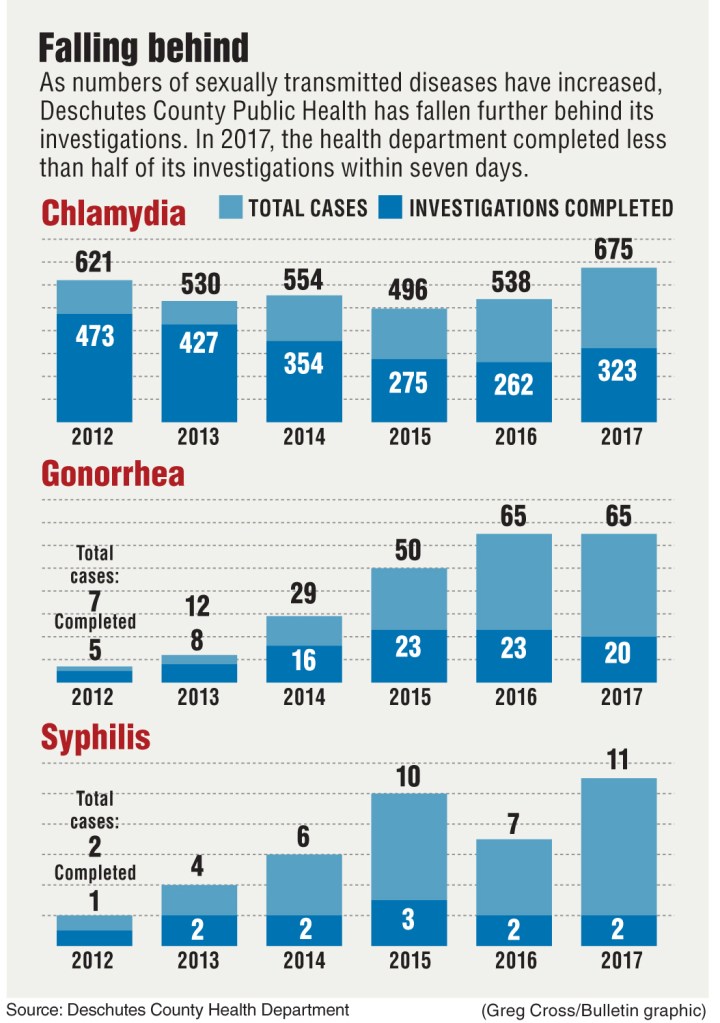Deschutes County likely to retain Bend family planning clinics
Published 12:00 am Saturday, June 2, 2018

- Deschutes County likely to retain Bend family planning clinics
Deschutes County health officials have found a way to retain reproductive health services in Bend and Redmond without an increase in county funding.
Deschutes Public Health Deputy Director Hillary Saraceno laid out a proposal for the Deschutes County Commission on Thursday to reinstate two full-time employees, whose salaries would be offset by state payments for the reproductive health services they provide.
In February, health department officials had proposed cutting the family health clinics from eight employees working four days a week in Bend and Redmond, to three employees working two days a week in Redmond only. That proposal would have saved about $1 million, freeing funds for investigations of sexually transmitted disease cases. But county commissioners told the health department to come back to the table with options to keep those services in Bend.
In the meantime, the Oregon Health Authority released details about how it would implement House Bill 3391, the Reproductive Health Equity Act signed into law last year, that created a $10 million fund with greater flexibility in billing and a higher reimbursement rate for providing family planning services.
“We didn’t know about that when we did our budget in February,” Saraceno said.
The commissioners approved the change Friday as part of a proposed budget that will go to a public hearing and final deliberations on June 18.
The new model shifts some of the nurses who worked in Deschutes family planning clinics to help with STD investigations, leaving two nurse practitioners for reproductive health.
The health department estimates those nurse practitioners can bring in another $300,000 in revenues by billing the state for their services, enough to cover their salaries and benefits.
Deschutes County applied for the state funding earlier this year, and has been operating under the new model since April.
“The first two months of implementing the new model, the clinic is full,” Saraceno told the county commissioners. “It’s hopping.”
Commissioners approved adding $131,300 from the general fund to spend on STD investigations and $88,000 for the women infants and children program, a nutrition program that helps pregnant women, new mothers and young children.
“I have trouble with the STD portion because it isn’t everybody,” Commissioner Phil Henderson said. “It’s a select group of people who are engaged in risky behaviors.”
STD rates have been rising throughout Oregon and the nation, but Deschutes County has some of the highest rates in the state after a 38 percent increase in gonorrhea, syphilis and chlamydia cases over the past five years. The vast majority, 82 percent of cases, were in people 29 or younger.
The number of gonorrhea cases in Deschutes County increased from seven in 2012, to 65 in 2017, an eightfold increase.
“That’s a faster increase than our population, a faster increase than my staff, and a faster increase than my resources,” Saraceno said. “This is one to watch.”
The trend is particularly disturbing, she said, because gonorrhea is increasingly becoming resistant to the last effective antibiotic treatment.
“We are seeing elsewhere in the world where the disease is not responding to medication,” Saraceno said.
Syphilis cases increased from four cases in 2014 to 11 in 2017, and six cases so far in 2018. The disease was nearly eradicated in the United States until it rebounded about five years ago.
The initial stages of infection generally don’t result in any symptoms, leading to a delay in diagnosis.
“People are going around not knowing they have it,” Saraceno said. “So they don’t get tested, and they don’t get treated, but they spread it.”
That’s led to re-emergence of congenital syphilis, where mothers pass on the infection to newborns, with eight cases in 2017 and two cases in 2018 statewide.
Chlamydia is more common but on the rise in the region, increasing from 530 case in 2013, to 675 cases in 2017.
Health officials attribute the rise to a cultural shift around sex. Dating apps have made sex more anonymous, and condom use has decreased with the changing nature of HIV infection.
“It’s gone from an almost universally fatal disease a treatable chronic disease,” said Dr. George Conway, Deschutes County health services director. “And because of that it doesn’t instill the same fear.”
But as transmission rates increased, the county health department has struggled to keep up with its STD investigations. When someone tests positive for one of those disease, the health department tries to track down that person’s sexual partners to get them in for testing and treatment in hopes of interrupting the spread.
In 2012, the health department completed investigations within seven days for 76 percent of chlamydia cases, 71 percent of gonorrhea cases, and 50 percent of syphilis cases. Despite pulling nurses from reproductive health services to help with the investigations, the health department is falling further behind. By 2017, they closed 48 percent of chlamydia investigations, 31 percent of gonorrhea cases and 18 percent of syphilis cases.
“As our numbers have gone up, we are not doing a good job in our response,” Saraceno said. “We’re not keeping up.”
The health department calculated that its employees spent 3,638 hours in 2017 on case investigations, an average of 70 hours per week. That’s the equivalent of about 1.6 full time employees.
— Reporter: 541-633-2162, mhawryluk@bendbulletin.com





